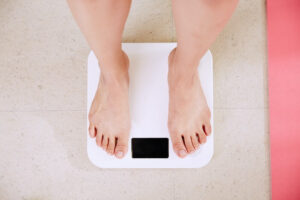Picture this: Two weeks ago you started your fat loss journey. You were motivated, you’ve made it this far with minimal mistakes. Every time you step on the scale to track your fat loss though, it’s the same number!
This back and forth numbers game with the scale to track fat loss has now turned into psychological warfare. You’re discouraged and stopped in your tracks again towards finally reaching your long term weight loss goal!
This story may sound familiar to your current situation. As an experienced personal trainer, many of my clients have had this same frustration which opens up the same conversation we’re about to have now!
Seeing progress is a key towards staying motivated and the scale may become more than a frenemy and turn into your enemy! The truth is, the scale isn’t always the best way to track fat loss.
The problem with the scale is that it doesn’t give you a full picture of what’s happening in the body. It’s a helpful tool that you should use, but it’s just one of many you should be utilizing!
If you are only using the scale to track fat loss then you may run into frustration and become discouraged.
When you start working out, your muscles grow as a result of various things, they hold more nutrients, and this alone can stagnate your weight loss for the first couple weeks! The exception to this would be something like a keto diet in which case you will lose water weight the first few weeks.
It should be noted however that you would not have lost anymore fat on a keto diet than you would have on a regular energy restriction diet.
If you’re not working out, you may be able to avoid this altogether though!
Women 50 plus in particular have a hard time losing weight when compared to men and it becomes even more important for this population to track fat loss with other methods in addition to the scale.
I have worked with numerous women clients that were 50 plus that made significant changes in their body and physical appearance without making a huge impact on the scale!
This was due to added muscle mass which improved their figure and boosted their metabolism!
The Best Way to Track Fat Loss

The best way to track fat loss is through DEXA scans, Bod Pod’s, hydrostatic weighing, or high end bioelectrical impedance scales. These methods can be extremely accurate but unfortunately can be expensive and/or not easily accessible.
If you can find somewhere to utilize one of these methods, go for it!
In this article however, I am going to focus on methods you can use everyday at home with minimal hassle that will tell you everything you need to know.
We will be covering the best methods to track fat loss at home which includes:
- Body measurements
- Progress photos
- The scale
- Affordable bioelectrical impedance scales
- Assessing how your clothes fit
Body Measurements to Track Fat Loss
Measuring once a week and recording your numbers is a healthy way to track your progress or lack thereof.
With body measurements you can also learn where you are losing fat which can be helpful and encouraging; especially for problem areas!
If you do use body measurements to track your fat loss, make sure to follow the rules below:
- Make sure to measure in the same spot each and every time!
- Measure under the same conditions such as having the same person measure you, the same time, the same day of the week each week, etc.
Below are common areas that you can measure. I would recommend picking a few based on problem areas you might be dealing with. For example, some women struggle to lose upper arm fat. Therefore, the upper arm would be a good measurement to track fat loss within this area.
Another common area of concern I see many struggle with as a trainer is lower ab definition, in this case the waist measurement will be one to track!
Waist: Measure at the narrowest part of your waist. This is typically at or just above the belly button.
Upper Arm: Measure at the widest part of the upper arm above the elbow.
Bust: A bust measurement applies to women and should be taken at the nipple line.
Thighs: Measure at the widest part of the thigh.
Chest: Chest measurements typically apply to men and should be taken at the widest part of the chest. This is typically just below the armpits.
Hips: Measure at the widest part of the hips.
Progress Photos
Progress photos are something you will wish you had taken at the start so take them now!
A front on photo and side photo are good photos to have and compare to for future reference. Try to take them in the same place with the same lighting too.
When it comes to progress photos, monthly comparisons will be a healthy frequency. Anything more often and changes may not be as apparent.
Body Weight Scales

Although I mentioned earlier that using just the scale may not be a great idea, it does have a place!
The utilization of a body weight bathroom scale becomes even more important when you have a large weight loss goal.
If your goal is to lose 25 pounds, 50 pounds, 100 plus pounds, then we both know that long term the scale does need to show a smaller number. In this regard, the scale is important.
When using the bathroom scale, make sure to follow these rules:
- Weight at the same time everyday. Morning time is the best!
- Weighing naked will help to keep numbers consistent and is recommended.
- You can weigh daily or weekly, both are fine. If you are weighing daily, don’t scoff over tiny fluctuations! Instead, measure from the beginning to the end of the week.
Bioelectrical Impedance Scales
Bioelectrical impedance scales send an undetectable electrical current throughout the body to calculate body fat percentage.
Bioelectrical Impedance Analysis (BIA) isn’t necessarily bad or great. The problem is the amount of variables from brand to brand and model to model.
Things such as age, gender, height, hydration, athleticism, and ethnicity can change the results you get. It is important to find a scale that will fit you.
Typical variations include hand held arm-to-arm models, leg-to-leg models, and models that connect to the hands and feet. Of these three different model styles, hand-to-hand tends to be the least accurate.
Some good brands that can be somewhat affordable are Tanita and InBody.
If you do decide to use a bioelectrical impedance scale, make sure to follow the rules below for the best results:
*Do not do a BIA if you have a pacemaker!
- If you have just eaten, wait three hours. The recommended time of day to do a BIA is just before your evening meal.
- If you’re dehydrated, sweaty, or overly hydrated your reading will be inaccurate.
- If you are an athlete, conduct your BIA in athlete mode if your bioelectrical impedance scale has this setting.
- Do the BIA exactly as directed by your bioelectrical impedance scale.
- Try to measure under the same conditions weekly.
Assessing How Your Clothes Fit
Based on my personal training experience, this is perhaps the most powerful way to see and feel changes when tracking your body fat, especially initially!
Oftentimes, when my clients ask me questions about their weight on the scale and express concern, I will tell them to evaluate how their clothes fit first.
There is no proper way to figure out if your clothes are fitting differently because you will just know!
Where your clothes fit differently will vary person to person throughout your weightloss journey. Many people will notice changes in the hips and waist first though, especially women!
So, What is The Best Way to Track Fat Loss
Hopefully you have begun to pick up that:
There is no “one best way to track fat loss”.
Some could argue that DEXA scans are the gold standard to track fat loss (and other body composition variables) which is true, BUT, a DEXA scan probably won’t tell you anything you didn’t already know.
If your clothes aren’t fitting differently, if your measurements haven’t changed, if the scale hasn’t changed long term, then a DEXA scan probably won’t tell you anything revolutionary!
Overall, the methods I chose to focus on to track fat loss are easy to do and will tell you what you need to know.
I would recommend using a few of the methods described above for a healthy, well rounded, and effective approach to track your fat loss!
Sources:
- Clark Nancy. Nancy Clark’s Sports Nutrition Guidebook. Human Kinetics, 2008.
- “Frequently Asked Questions.” Tanita, https://tanita.eu/help-guides/f-a-q/#:~:text=How%20accurate%20is%20a%20Tanita,standards%20of%20body%20composition%20analysis.).

